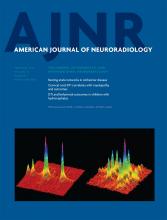Index by author
Carter, R.E.
- FELLOWS' JOURNAL CLUBSpineYou have accessCervical Spine MR Imaging Findings of Patients with Hirayama Disease in North America: A Multisite StudyV.T. Lehman, P.H. Luetmer, E.J. Sorenson, R.E. Carter, V. Gupta, G.P. Fletcher, L.S. Hu and A.L. KotsenasAmerican Journal of Neuroradiology February 2013, 34 (2) 451-456; DOI: https://doi.org/10.3174/ajnr.A3277
The authors sought to determine if Hirayama disease in North America has the same imaging findings as it does in Asia. They assessed imaging studies in 21 patients and looked for loss of attachment of posterior dura, lower cord atrophy and high T2 signal, loss of cervical lordosis, and anterior dural shift in flexion. These 4 findings were able to discriminate patients from healthy controls. MR imaging findings in white North American patients with Hirayama disease include loss of attachment on neutral images and forward displacement of the dura with flexion. Findings are often present on neutral MR images and, in the appropriate clinical scenario, should prompt flexion MR imaging to evaluate anterior dural shift.
Castillo, M.
- EditorialsYou have accessRecognizing Famous FacesM. CastilloAmerican Journal of Neuroradiology February 2013, 34 (2) 257-258; DOI: https://doi.org/10.3174/ajnr.A3100
Cen, S.Y.
- EDITOR'S CHOICESpineYou have accessDiffusion Tensor Imaging Correlates with the Clinical Assessment of Disease Severity in Cervical Spondylotic Myelopathy and Predicts Outcome following SurgeryJ.G.A. Jones, S.Y. Cen, R.M. Lebel, P.C. Hsieh and M. LawAmerican Journal of Neuroradiology February 2013, 34 (2) 471-478; DOI: https://doi.org/10.3174/ajnr.A3199
The relationship between DTI findings and clinical severity of cervical myelopathy due to spondylosis was studied in 30 patients. Low fractional anisotropy correlated with initial clinical assessments and patients with high FA showed better outcome. T2 signal intensity was associated with functional status but did not predict outcome whereas degree of stenosis lacked correlation with all clinical parameters. Thus, DTI may be a useful diagnostic tool for assessing disease severity in these patients and its predictive value regarding postoperative outcome may improve surgical decision making.
Chaudhry, S.A.
- FELLOWS' JOURNAL CLUBNeurointerventionOpen AccessMicrocatheter to Recanalization (Procedure Time) Predicts Outcomes in Endovascular Treatment in Patients with Acute Ischemic Stroke: When Do We Stop?A.E. Hassan, S.A. Chaudhry, J.T. Miley, R. Khatri, S.A. Hassan, M.F.K. Suri and A.I. QureshiAmerican Journal of Neuroradiology February 2013, 34 (2) 354-359; DOI: https://doi.org/10.3174/ajnr.A3202
This study addresses the relationship among procedure time, recanalization, and clinical outcomes in patients with acute ischemic stroke undergoing endovascular treatment. Demographics, NIHSS scores before and 1 day after the procedure, and modified Rankin Scale scores were assessed in 209 patients. Patients with procedure times ≤30 minutes had lower rates of unfavorable outcome at discharge compared with patients with procedure times ≥30 minutes. Rates of favorable outcomes in endovascularly treated patients after 60 minutes were lower than rates observed with placebo treatment. Unfavorable outcome was positively associated with age, admission NIHSS strata, and longer procedure times.
Chen, K.
- FunctionalOpen AccessAlterations of Directional Connectivity among Resting-State Networks in Alzheimer DiseaseR. Li, X. Wu, K. Chen, A.S. Fleisher, E.M. Reiman and L. YaoAmerican Journal of Neuroradiology February 2013, 34 (2) 340-345; DOI: https://doi.org/10.3174/ajnr.A3197
Chen, Y.-L.
- FELLOWS' JOURNAL CLUBNeurointerventionYou have accessProspective Comparison of Angio-Seal versus Manual Compression for Hemostasis after Neurointerventional Procedures under Systemic HeparinizationH.-F. Wong, C.-W. Lee, Y.-L. Chen, Y.-M. Wu, H.-H. Weng, Y.-H. Wang and H.-M. LiuAmerican Journal of Neuroradiology February 2013, 34 (2) 397-401; DOI: https://doi.org/10.3174/ajnr.A3226
This article addresses the utility of Angio-Seal versus manual hemostasis in anticoagulated patients following neurointerventional procedures. In a study of 174 punctures, 104 were closed with Angio-Seal and the rest with manual compression. All patients had activated clotting time values between 250–500 seconds at the time of closure. Mean hemostasis times were significantly longer with manual compression and hematomas 3 times more common. Using Angio-Seal led to arterial occlusion in 1 patient who was successfully revascularized. Thus, Angio-Seal is fast and effective in this setting.
Cheng, S.
- Extracranial VascularOpen AccessClinical Risk Factors and CT Imaging Features of Carotid Atherosclerotic Plaques as Predictors of New Incident Carotid Ischemic Stroke: A Retrospective Cohort StudyR. Magge, B.C. Lau, B.P. Soares, S. Fischette, S. Arora, E. Tong, S. Cheng and M. WintermarkAmerican Journal of Neuroradiology February 2013, 34 (2) 402-409; DOI: https://doi.org/10.3174/ajnr.A3228
Chitnis, T.
- PediatricsYou have accessDiffusion Tensor Analysis of Pediatric Multiple Sclerosis and Clinically Isolated SyndromesM.S. Vishwas, B.C. Healy, R. Pienaar, M.P. Gorman, P.E. Grant and T. ChitnisAmerican Journal of Neuroradiology February 2013, 34 (2) 417-423; DOI: https://doi.org/10.3174/ajnr.A3216
Choi, I.S.
- SpineYou have accessSpinal Arteriovenous Metameric Syndrome: Angioarchitecture and their PrognosisI.S. ChoiAmerican Journal of Neuroradiology February 2013, 34 (2) 464-465; DOI: https://doi.org/10.3174/ajnr.A3318
Chow, M.
- NeurointerventionYou have accessCanadian Experience with the Pipeline Embolization Device for Repair of Unruptured Intracranial AneurysmsC.J. O'Kelly, J. Spears, M. Chow, J. Wong, M. Boulton, A. Weill, R.A. Willinsky, M. Kelly and T.R. MarottaAmerican Journal of Neuroradiology February 2013, 34 (2) 381-387; DOI: https://doi.org/10.3174/ajnr.A3224








